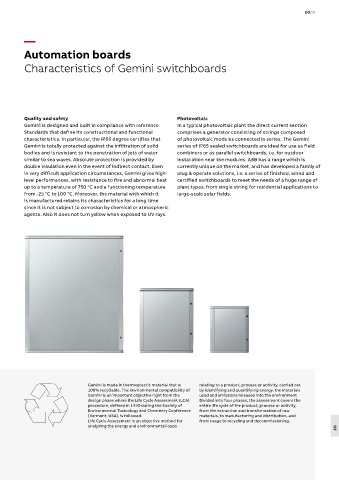Page 2807 - Din prodcuts 2020
P. 2807
20/9
—
Automation boards
Characteristics of Gemini switchboards
Quality and safety Photovoltaic
Gemini is designed and built in compliance with reference In a typical photovoltaic plant the direct current section
Standards that define its constructional and functional comprises a generator consisting of strings composed
characteristics. In particular, the IP66 degree certifies that of photovoltaic modules connected in series. The Gemini
Gemini is totally protected against the infiltration of solid series of IP65 sealed switchboards are ideal for use as field
bodies and is resistant to the penetration of jets of water combiners or as parallel switchboards, i.e. for outdoor
similar to sea waves. Absolute protection is provided by installation near the modules. ABB has a range which is
double insulation even in the event of indirect contact. Even currently unique on the market, and has developed a family of
in very difficult application circumstances, Gemini gives high- plug & operate solutions, i.e. a series of finished, wired and
level performances, with resistance to fire and abnormal heat certified switchboards to meet the needs of a huge range of
up to a temperature of 750 °C and a functioning temperature plant types: from single string for residential applications to
from -25 °C to 100 °C. Moreover, the material with which it large-scale solar fields.
is manufactured retains its characteristics for a long time
since it is not subject to corrosion by chemical or atmospheric
agents. Also it does not turn yellow when exposed to UV rays.
Gemini is made in thermoplastic material that is relating to a product, process or activity, carried out
100% recyclable. The environmental compatibility of by identifying and quantifying energy, the materials
Gemini is an important objective right from the used and emissions released into the environment.
design phase where the Life Cycle Assessment (LCA) Divided into four phases, the assessment covers the
procedure, defined in 1990 during the Society of entire life cycle of the product, process or activity,
Environmental Toxicology and Chemistry Conference from the extraction and transformation of raw
(Vermont, USA), is followed. materials, to manufacturing and distribution, and
Life Cycle Assessment is an objective method for from usage to recycling and decommissioning.
analyzing the energy and environmental loads
20

